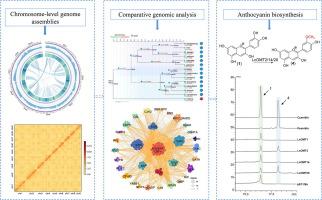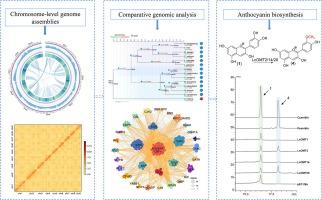金银花基因组揭示耐寒性和花青素生物合成的分子机制
IF 13
1区 综合性期刊
Q1 MULTIDISCIPLINARY SCIENCES
引用次数: 0
摘要
金银花(lonicera caerulea L.)是一种值得注意的肉质果树,也是一种著名的药用植物,具有特殊的冬季适应性和早熟性,是功能花青素,特别是花青素-3-葡萄糖苷最丰富的来源。其耐寒性和花青素生物合成的分子机制仍不清楚。目的介绍蓝金银花的染色体尺度基因组,旨在研究蓝金银花这些特征的遗传基础。方法利用PacBio HiFi reads和Hi-C数据构建高质量的蓝金银花基因组。比较基因组学和转录组学分析阐明了抗冻性和花青素生物合成的分子机制。结果对柠条和粳稻的比较基因组学分析表明,重复基因的动态变化有助于柠条和粳稻的植物化学重建和环境适应。此外,ABA和ICE-CBF-COR信号通路与黑穗草的抗冻性密切相关。全基因组鉴定和生化功能表明,3种花青素3′,5′- o -甲基转移酶(LcOMT2, LcOMT14和LcOMT20)和2种3′- o -糖基转移酶(LcUGT78X1和LcUGT95P1)负责花青素的生物合成。此外,LcUGT78X1被认为是花青素-3-葡萄糖苷积累的有效糖基转移酶。结论本研究阐明了ABA和ICE-CBF-COR信号通路在提高花青素耐寒性中的重要作用,并鉴定出高效的花青素生物合成酶。这些发现促进了对忍冬属植物的环境适应和植物化学物质产生的认识。本文章由计算机程序翻译,如有差异,请以英文原文为准。


Lonicera caerulea genome reveals molecular mechanisms of freezing tolerance and anthocyanin biosynthesis
Introduction
Lonicera caerulea L. (blue honeysuckle) is a noteworthy fleshy-fruited tree and a prominent medicinal plant, which possesses notable characteristics such as exceptional resilience to winter conditions and early maturation, and the richest source of functional anthocyanins, particularly cyanidin-3-glucoside. The molecular mechanisms responsible for its freezing tolerance and anthocyanin biosynthesis remain largely unknown.
Objectives
Here, a chromosome-scale genome of L. caerulea was presented, aiming to examine the genetic foundations that underlie these characteristics of blue honeysuckle.
Methods
The PacBio HiFi reads and Hi-C data were used to construct high-quality genome of blue honeysuckle. Comparative genomic and transcriptomic analyses were conducted to elucidate the molecular mechanisms of freezing tolerance and anthocyanin biosynthesis.
Results
Comparative genomics analysis between L. caerulea and L. japonica revealed that the dynamic changes of duplicated genes contributed to their phytochemical reconstruction and environmental adaptation. Moreover, the ABA and ICE-CBF-COR signaling pathways were closely correlated to the freezing tolerance of L. caerulea. Genome-wide identification and biochemical function indicated that three anthocyanin 3′,5′-O-methyltransferases (LcOMT2, LcOMT14, and LcOMT20) and two 3′-O-glycosyltransferases (LcUGT78X1 and LcUGT95P1) were responsible for anthocyanin biosynthesis. In addition, LcUGT78X1 was regarded as the potent glycosyltransferase for the accumulation of cyanidin-3-glucoside in L. caerulea.
Conclusion
This research elucidates the crucial roles of the ABA and ICE-CBF-COR signaling pathways in enhancing freezing tolerance, while also identifying highly efficient anthocyanin biosynthetic enzymes in L. caerulea. These findings advance the understanding of environmental adaptation and phytochemical production in Lonicera species.
求助全文
通过发布文献求助,成功后即可免费获取论文全文。
去求助
来源期刊

Journal of Advanced Research
Multidisciplinary-Multidisciplinary
CiteScore
21.60
自引率
0.90%
发文量
280
审稿时长
12 weeks
期刊介绍:
Journal of Advanced Research (J. Adv. Res.) is an applied/natural sciences, peer-reviewed journal that focuses on interdisciplinary research. The journal aims to contribute to applied research and knowledge worldwide through the publication of original and high-quality research articles in the fields of Medicine, Pharmaceutical Sciences, Dentistry, Physical Therapy, Veterinary Medicine, and Basic and Biological Sciences.
The following abstracting and indexing services cover the Journal of Advanced Research: PubMed/Medline, Essential Science Indicators, Web of Science, Scopus, PubMed Central, PubMed, Science Citation Index Expanded, Directory of Open Access Journals (DOAJ), and INSPEC.
 求助内容:
求助内容: 应助结果提醒方式:
应助结果提醒方式:


